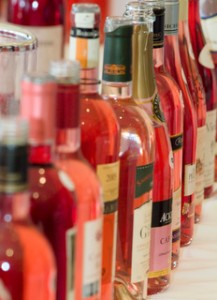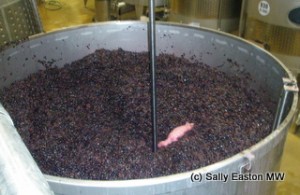What is that makes pink wine pink?
In less than a decade, rosé wine has gone from being little more than a summer seasonal afterthought of two or three wines on the retail shelves, to dedicated all-year-round entire sections of the wine wall.
What’s that all about, and if white wine comes from white grapes, and red wine from red grapes, where does pink wine come from, given there aren’t really any pink grapes?

In the pink
In the first instance, rosé, or pink, wine offers all the bright, refreshing, crunchy characteristics of a (usually) un-oaked white wine, plus some of the rich berry fruit flavours of red wine. They are ideal for summer drinking, with summer and forest fruit berry flavours, yet without the grippy tannins that are typical (and essential) in most reds. But they also have a year-round appeal that we have finally cottoned-on to.
As an aside, there are some reds that suit chilling well, but chilling tannic wines accentuates the tannins, so for cool, tasty wine, pink can be a great unifying factor.
Along with the growth of pink production has come great stylistic diversity. Style varies from the medium-dry/medium-sweet white grenaches and zinfandels from the USA, and many wines from all over the world labelled ‘blush’, to bone dry, serious aperitifs or even food-demanding styles, often from parts of France such as Provence in the south and Tavel in the Rhône valley. Everything exists in between these two extremes.
In the second instance, the way pink wine is made is protected in the European Union (EU). Within the EU rosé wine must NOT be made by blending red and white wine together.
Blending red and white is allowed in non-EU countries, and those wines can be imported into the EU, but rosé wines made in EU countries have to be made by a traditional method.
The only exception to this rule is in Champagne, where rosé Champagne can be made by blending white and red wines together.
Apart from the Champagne exception, in EU countries, pink wine must be made using ONLY red grapes. Colour compounds are found in the skins of grapes, which is why rosé wine cannot be made from white grapes. Rosé wines must be made by the bleeding, or saignage, method.
By macerating grape juice and skins (after crushing the berries a little just after harvest) for a shorter to longer period of time, less or more colour is extracted from the skins. For a very pale rosé, red grapes may be pressed directly – a bit of a squash and some colour comes away from the skin (vin gris). More usually skin and juice is macerated from a few to several hours, after which the coloured juice is drained off (bleeding/saignage) to continue its fermentation as for a white wine (i.e. without skins). Judging the desired colour of the finished wine before it has fermented is a skilled and complex job.

Red grapes macerating in their juice
Globally nine out of ten bottles of rosé are made by this ‘bleeding’ method, using just red grapes. The poshest French pink wines such as those from Provence and the Rhône’s Tavel, are made by this maceration method. Indeed pinks from Provence account for 5% of all rosés made in the world.
Merely blending red and white wine together to make pink is by comparison very simple. But because so many new world countries allow it, there was a proposal in 2009 in the EU to allow this blending option for production in the EU, in part in an attempt to increase the competitiveness of rosé wines from EU countries.
The proposal did not succeed because the three biggest global wine producing countries, France, Italy and Spain, led a successful lobbying campaign to prevent it, arguing that blending red and white to make pink belittled their traditionally made products and would lower the quality of rosé wines. Their argument won the day, so EU pink wines continue to be made by the ‘bleeding’ method. Given that France alone makes nearly 30% of the world’s pink wine, its voice was bound to carry some authority.
One more thing about rosé wine. Freshness is key to pink wine. They are generally made for young drinking (though there are exceptions to this rule). A large part of the joy about drinking pink is the freshness, the vibrancy, the brightness of hue, indeed the youth of them. This also feeds in to the original summer-drinking idea. The northern hemisphere harvest is in Sept/Oct, so by the time the wines have finished fermenting, settled over winter they’re at their peak of freshness as summer emerges. It’s a similar pattern in the southern hemisphere with harvest in Feb/March/April…



